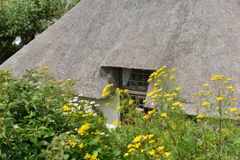Among the earlier literary visitors to Orkney are Victor Frankenstein and his Creature, in Mary Shelley’s novel of 1818.
At this point in the novel, Victor is trying to put behind him the horror and guilt of having created his ‘monster’, and with his friend Henry Clerval, he sets off on a tour of Britain. These kind of domestic tours were very popular in the early nineteenth century and Victor’s account starts like a guidebook or memoir, describing the picturesque sights. But as he moves further north, his descriptions of the landscape and people become interspersed with very different feelings as he cannot shake off the idea that he has ‘drawn down a terrible curse’ on himself. At Perth, he and Clerval split up when Victor realises he cannot shake off his Creature and decides to grant him his wish for a female companion. The best place for this work, Victor decides, is Orkney.
Why does Mary Shelley choose Orkney? She had not visited the islands and they were not represented in literature (Walter Scott’s novel The Pirate would not be published until 1821). Shelley doesn’t want local colour; Victor choses an island simply because it is remote and featureless so Shelley picks somewhere no one is likely to know much about. Although the Western Islands were well-known through poems, novels and travel books at this time, the Northern Islands were not. Victor wants a place that will stop him thinking about what he’s doing—just as the few inhabitants of the island seem to him ‘benumbed by want and squalid poverty’ so he imagines he will be psychologically ‘benumbed’ as he fashions a second Creature.
But just as thoughts of horror permeated Victor’s picturesque tour of Scotland, so the landscape of Orkney takes on a horrifying aspect. The ‘sublime’ at this time was thought of as a way of experiencing the outside world through our emotions and imagination. This frequently meant the effects of spectacular mountains and ravines, as in Victor’s native Switzerland. But Edmund Burke, who wrote the best-known theory of the sublime in 1757, points out that it includes ideas of what he calls ‘privation’, defined as ‘vacuity, darkness, solitude, and silence’. So Orkney represents a horrifying sublimity, or as Victor puts it, a ‘monotonous, yet ever-changing scene’ and a ‘desolate and appalling landscape’. And soon Victor is himself overtaken by the horror of what he is doing. When he realises that his first creation has followed him to the island, he violently destroys his female Creature before she is even finished and leaves Orkney.
Read more!
Mary Shelley, Frankenstein: 1818 Text, ed. M. Butler (Oxford, 1993)
Edmund Burke, A Philosophical Enquiry into the Origin of our Ideas of the Sublime and Beautiful, ed. A. Phillips (Oxford, 1990)


No comments:
Post a Comment